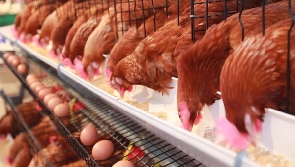The United States Department of Agriculture (USDA) is forecasting an increase in domestic chicken production from the 60,000 metric tonnes recorded in 2023 to 70,000 metric tonnes this year.
The department, in its Ghana Poultry Voluntary Update 2024, said local chicken production is expected to see growth due to the anticipated decrease in the price of corn on the local market, following early reports of favourable harvests in the 2023/24 season, which started in August 2023 and is expected to continue in the year.
The domestic poultry sector has been hampered by a steady increase in feeding costs over the past few years, with feed expenses constituting a significant portion of total production costs.
Nonetheless, the USDA has forecasted that prices of feed ingredients, such as soybean meal and concentrates, will likely remain stable in 2024 as suppliers work to deplete existing stocks.
The report disclosed that increased demand for live birds during key festive seasons will drive price up and make domestic chicken meat production attractive against imported frozen chicken. This shift is attributed to consumers’ growing awareness of the importance of prioritising their health requirements.
Furthermore, the USDA asserts that the anticipated increase in domestic chicken meat production this year is partially attributed to the government’s initiative to revitalise the chicken meat industry through the recently launched second phase of its flagship programme, Planting for Food and Jobs II (PFJ 2.0).
It also noted that the heightened projection for domestic chicken production is partly a result of the elevated import charges at the ports, which are incentivising domestic production to meet the continually increasing demand for chicken meat.
The Ministry of Food and Agriculture (MoFA) reports that the national demand for poultry meat alone is approximately 400,000 tonnes, while local production ranges from 50,000 to just about 57,871 tonnes. This indicates that poultry imports continue to rise annually.
MoFA has identified that broiler meat importation accounts for over 80 percent of total meat imports into the country. Additionally, broiler production has been recognised as the fastest means of reducing meat imports through local production or import substitution.
In light of the significant import bills, MoFA consistently advocates for the development of a competitive and efficient livestock industry in the local market. The initiative is expected to revitalise the broiler industry, boost domestic production, decrease livestock product imports and foster employment generation.
Ultimately, it seeks to enhance livelihoods and contribute to the growth of the economy.
Business News of Friday, 12 April 2024
Source: thebftonline.com













